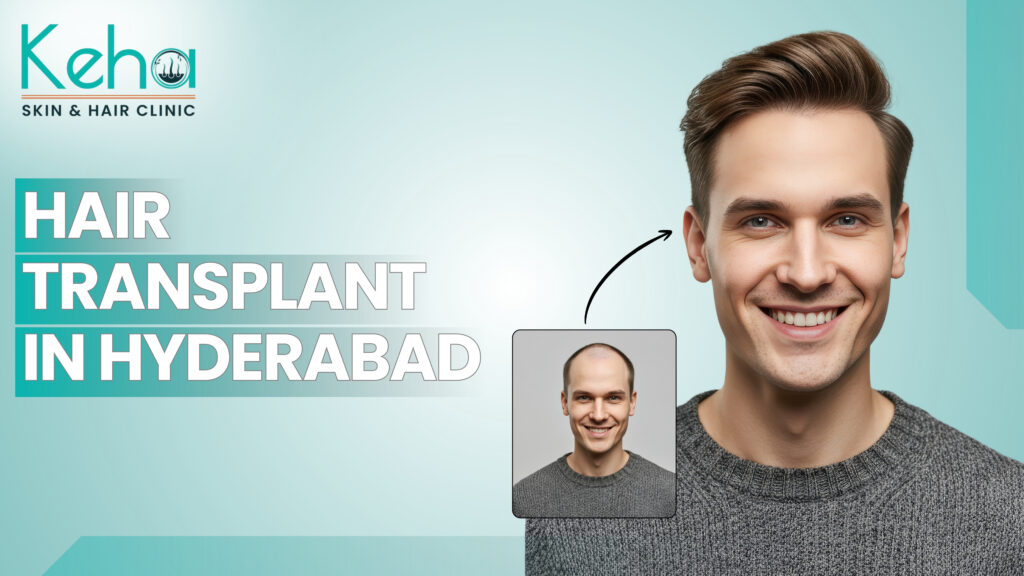Hair fall doesn’t just change your appearance—it changes how you feel about yourself. For many men and women in Hyderabad, receding hairlines and bald spots lead to loss of confidence in both personal and professional life. That’s where hair transplant surgery steps in, offering a permanent, natural-looking solution.
If you’ve been searching for answers on whether this treatment is worth it, how much it costs, and what kind of results you can expect, this complete guide will walk you through everything you need to know before booking your consultation.
What is a Hair Transplant?
A hair transplant is a minimally invasive surgical procedure where healthy hair follicles are removed from a donor site (usually the back or sides of your scalp) and implanted into thinning or bald areas. These follicles then grow naturally, blending seamlessly with your existing hair.
Unlike wigs or hair systems, transplants give you your own natural hair back—and in most cases, the results are permanent.
Types of Hair Transplant Techniques in Hyderabad
Hair Transplant clinics in Hyderabad offer several transplant options. The technique chosen depends on your level of hair loss, donor hair quality, and budget.
- FUT (Follicular Unit Transplantation)
- A strip of scalp is removed from the donor area.
- Follicles are extracted from this strip and transplanted.
- Leaves a linear scar but allows more grafts in one session.
- FUE (Follicular Unit Extraction)
- Individual follicles are removed directly from the donor area using tiny punches.
- Minimal scarring, faster recovery, and natural-looking results.
- Preferred by most patients today.
- DHI (Direct Hair Implantation)
- An advanced form of FUE using an implanter pen.
- Provides precise angle, depth, and direction control for a natural hairline.
- Slightly more expensive.
- Robotic/Automated FUE
- Uses robotic assistance for follicle harvesting.
- Ensures speed, precision, and reduced human error.
- Available only in select high-end clinics.
Step-by-Step Process of a Hair Transplant
Knowing what to expect makes the journey smoother. Here’s how most Hyderabad clinics approach the procedure:
Step 1: Consultation
Your doctor will check your scalp, review medical history, and design a suitable hairline. Sometimes blood tests are ordered to rule out conditions affecting hair growth.
Step 2: Donor Area Preparation
The donor area is trimmed and numbed with local anaesthesia.
Step 3: Follicle Extraction
- FUT: Strip removed, and follicles separated.
- FUE/DHI: Individual follicles extracted with a punch tool.
Step 4: Recipient Site Preparation
Tiny slits are created in the bald area. In DHI, follicles are implanted directly without slits.
Step 5: Graft Implantation
Follicles are placed one by one to mimic natural growth patterns. Special attention is given to the hairline for a realistic look.
Step 6: Recovery & Healing
Bandages are applied, and you’ll be advised on aftercare. Most patients can return to work in 3–5 days.
Hair Transplant Cost in Hyderabad
The cost depends on technique, surgeon’s expertise, clinic reputation, and number of grafts needed.
Per Graft Pricing (Hyderabad Average)
- FUT: ₹30 – ₹45 per graft
- FUE: ₹35 – ₹60 per graft
- DHI: ₹60 – ₹80 per graft
- Robotic FUE: ₹80 – ₹100 per graft
Overall Cost Estimate
- 1000 grafts: ₹30,000 – ₹60,000
- 2000 grafts: ₹70,000 – ₹1.2 Lakhs
- 3000+ grafts: ₹1.5 – ₹2 Lakhs+
Some clinics include PRP sessions in the package to improve graft survival. Always ask for all-inclusive pricing to avoid hidden charges.
Choosing the Right Hair Transplant Clinic in Hyderabad
With so many options, how do you decide? Use this checklist:
- Experience of the Surgeon – Look for at least 5–10 years of experience.
- Technology Used – Modern tools like sapphire blades, implanter pens, or robotic FUE.
- Before-and-After Results – Genuine photos or patient testimonials.
- Hygiene & Safety – Clinics should follow strict sterilisation standards.
- Transparent Costs – Be wary of very cheap offers. Quality work has fair pricing.
Expected Results & Recovery Timeline
- Week 1: Redness, swelling, and mild scabbing.
- Weeks 2–3: Temporary “shedding” of transplanted hairs (normal process).
- Month 3–4: Visible new hair growth begins.
- Month 6: Noticeable density improvement.
- Month 9–12: Full results visible with permanent growth.
Transplanted hair continues to grow for life, though surrounding natural hair may thin with age.
Boosting Results with Supporting Treatments
To make your transplant last longer and look better, doctors may recommend:
- PRP (Platelet-Rich Plasma) Therapy: Stimulates follicle healing and boosts density.
- Minoxidil: A topical solution that promotes hair regrowth.
- Finasteride: A prescription tablet that slows further hair loss.
- Lifestyle Tips: Protein-rich diet, scalp massages, and stress control.
A hair transplant in Hyderabad can transform not just your looks but your confidence. With the right clinic, advanced technology, and proper aftercare, you can enjoy natural, permanent results that blend seamlessly with your personality.
At Keha Skin & Hair Clinic, we know hair loss isn’t just about looks. That’s why we combine science, skill, and compassion to restore not just hair, but confidence. Call us today at +91-9390512365 and let’s begin your journey toward a fuller, happier you.
FAQs
Q: Is the procedure painful?
A: Local anaesthesia ensures minimal pain. You may feel mild soreness after surgery, but it subsides quickly.
Q: How long do results last?
A: Transplanted hair is permanent. However, untreated surrounding hair may thin, so maintenance is key.
Q: Can women undergo hair transplants?
A: Yes, women with thinning or patchy baldness can benefit, though technique and expectations differ.
Q: Are there risks involved?
A: Risks are minimal when performed by experts. Possible side effects include temporary swelling, infection, or shock loss.
Q: How soon can I go back to work?
A: Light office work is possible in 3–5 days. Avoid gym, swimming, or heavy exercise for 2 weeks.
Q: Do I need multiple sessions?
A: This depends on your level of baldness. Mild cases may need one session; advanced baldness may need two.


